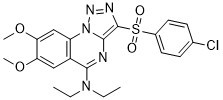Targocil is a antibiotic, inhibiting a late step in wall teichoic acid biosynthesis and inducing the cell wall stress stimulon in staphylococcus aureus.
Physicochemical Properties
| Molecular Formula | C21H22CLN5O4S |
| Molecular Weight | 475.948 |
| Exact Mass | 475.108 |
| Elemental Analysis | C, 53.00; H, 4.66; Cl, 7.45; N, 14.71; O, 13.45; S, 6.74 |
| CAS # | 1200443-21-5 |
| Related CAS # | 1200443-21-5 |
| PubChem CID | 44547009 |
| Appearance | Solid powder |
| LogP | 4.707 |
| Hydrogen Bond Donor Count | 0 |
| Hydrogen Bond Acceptor Count | 8 |
| Rotatable Bond Count | 7 |
| Heavy Atom Count | 32 |
| Complexity | 728 |
| Defined Atom Stereocenter Count | 0 |
| SMILES | ClC1C([H])=C([H])C(=C([H])C=1[H])S(C1=C2N=C(C3=C([H])C(=C(C([H])=C3N2N=N1)OC([H])([H])[H])OC([H])([H])[H])N(C([H])([H])C([H])([H])[H])C([H])([H])C([H])([H])[H])(=O)=O |
| InChi Key | TYNZGYMGTTUYKZ-UHFFFAOYSA-N |
| InChi Code | InChI=1S/C21H22ClN5O4S/c1-5-26(6-2)19-15-11-17(30-3)18(31-4)12-16(15)27-20(23-19)21(24-25-27)32(28,29)14-9-7-13(22)8-10-14/h7-12H,5-6H2,1-4H3 |
| Chemical Name | 3-(4-Chlorophenylsulfonyl)-N,N-diethyl-7,8-dimethoxy-[1,2,3]triazolo[1,5-a]quinazolin-5-amine |
| Synonyms | QC-993; QC 993; QC993; Targocil; |
| HS Tariff Code | 2934.99.9001 |
| Storage |
Powder-20°C 3 years 4°C 2 years In solvent -80°C 6 months -20°C 1 month |
| Shipping Condition | Room temperature (This product is stable at ambient temperature for a few days during ordinary shipping and time spent in Customs) |
Biological Activity
| ln Vitro | The MIC for Targocil in relation to S. Newman, MW2, MG2375, and MG2389 strains of aureus had a concentration of 1 μg/mL. Targocil exhibited outstanding performance in dealing with S. MSSA and MRSA isolates with MICs ranging from 1 to 2 μg/mL were among the aureus isolates from probable instances of bacterial keratitis. Derived from 1835F03, tartagocil has superior efficacy against all isolates of keratitis when compared to the original lead chemical, 1835F03. Bovine serum was found to exhibit a discernible mild reduction of 1835F03 and Targocil's in vitro antibacterial activity, resulting in a 4- to 8-fold increase in their respective MICs. Even after 24 hours of exposure, HCEC found targocil at 5 μg/mL to be only somewhat harmful when compared to the vehicle alone. Nevertheless, at every investigated time point, 40 μg/mL targrocil was hazardous. When HCEC was present, Targocil quickly stopped Newman and MG2375 from growing in vitro at 10×MIC [1]. |
| References | [1]. Suzuki T, et al. In vitro antimicrobial activity of wall teichoic acid biosynthesis inhibitors against Staphylococcus aureus isolates. Antimicrob Agents Chemother. 2011 Feb;55(2):767-74 |
Solubility Data
| Solubility (In Vitro) | DMSO : ~33.33 mg/mL (~70.03 mM) |
| Solubility (In Vivo) |
Solubility in Formulation 1: ≥ 2.5 mg/mL (5.25 mM) (saturation unknown) in 10% DMSO + 90% Corn Oil (add these co-solvents sequentially from left to right, and one by one), clear solution. For example, if 1 mL of working solution is to be prepared, you can add 100 μL of 25.0 mg/mL clear DMSO stock solution to 900 μL of corn oil and mix evenly. Solubility in Formulation 2: 10% DMSO+90% Corn Oil: ≥ 2.5 mg/mL (5.25 mM) (Please use freshly prepared in vivo formulations for optimal results.) |
| Preparing Stock Solutions | 1 mg | 5 mg | 10 mg | |
| 1 mM | 2.1011 mL | 10.5053 mL | 21.0106 mL | |
| 5 mM | 0.4202 mL | 2.1011 mL | 4.2021 mL | |
| 10 mM | 0.2101 mL | 1.0505 mL | 2.1011 mL |
